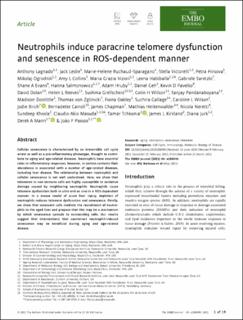| dc.contributor.author | Lagnado, Anthony | |
| dc.contributor.author | Leslie, Jack | |
| dc.contributor.author | Ruchaud-Sparagano, Marie-Helene | |
| dc.contributor.author | Victorelli, Stella | |
| dc.contributor.author | Hirsova, Petra | |
| dc.contributor.author | Ogrodnik, Mikolaj | |
| dc.contributor.author | Collins, Amy L | |
| dc.contributor.author | Vizioli, Maria Grazia | |
| dc.contributor.author | Habiballa, Leena | |
| dc.contributor.author | Saretzki, Gabriele | |
| dc.contributor.author | Evans, Shane A | |
| dc.contributor.author | Salmonowicz, Hanna | |
| dc.contributor.author | Hruby, Adam | |
| dc.contributor.author | Geh, Daniel | |
| dc.contributor.author | Pavelko, Kevin D | |
| dc.contributor.author | Dolan, David William Peter | |
| dc.contributor.author | Reeves, Helen L | |
| dc.contributor.author | Grellscheid, Sushma Nagaraja | |
| dc.contributor.author | Wilson, Colin H | |
| dc.contributor.author | Pandanaboyana, Sanjay | |
| dc.contributor.author | Doolittle, Madison | |
| dc.contributor.author | von Zglinicki, Thomas | |
| dc.contributor.author | Oakley, Fiona | |
| dc.contributor.author | Gallage, Suchira | |
| dc.contributor.author | Wilson, Caroline L | |
| dc.contributor.author | Birch, Jodie | |
| dc.contributor.author | Carroll, Bernadette | |
| dc.contributor.author | Chapman, James | |
| dc.contributor.author | Heikenwalder, Mathias | |
| dc.contributor.author | Neretti, Nicola | |
| dc.contributor.author | Khosla, Sundeep | |
| dc.contributor.author | Masuda, Claudio Akio | |
| dc.contributor.author | Tchkonia, Tamar | |
| dc.contributor.author | Kirkland, James L | |
| dc.contributor.author | Jurk, Diana | |
| dc.contributor.author | Mann, Derek A. | |
| dc.contributor.author | Passos, João F | |
| dc.date.accessioned | 2022-04-01T11:31:07Z | |
| dc.date.available | 2022-04-01T11:31:07Z | |
| dc.date.created | 2022-01-19T13:41:39Z | |
| dc.date.issued | 2021 | |
| dc.identifier.issn | 0261-4189 | |
| dc.identifier.uri | https://hdl.handle.net/11250/2989260 | |
| dc.description.abstract | Cellular senescence is characterized by an irreversible cell cycle arrest as well as a pro-inflammatory phenotype, thought to contribute to aging and age-related diseases. Neutrophils have essential roles in inflammatory responses; however, in certain contexts their abundance is associated with a number of age-related diseases, including liver disease. The relationship between neutrophils and cellular senescence is not well understood. Here, we show that telomeres in non-immune cells are highly susceptible to oxidative damage caused by neighboring neutrophils. Neutrophils cause telomere dysfunction both in vitro and ex vivo in a ROS-dependent manner. In a mouse model of acute liver injury, depletion of neutrophils reduces telomere dysfunction and senescence. Finally, we show that senescent cells mediate the recruitment of neutrophils to the aged liver and propose that this may be a mechanism by which senescence spreads to surrounding cells. Our results suggest that interventions that counteract neutrophil-induced senescence may be beneficial during aging and age-related disease. | en_US |
| dc.language.iso | eng | en_US |
| dc.publisher | Embo Press | en_US |
| dc.rights | Navngivelse 4.0 Internasjonal | * |
| dc.rights.uri | http://creativecommons.org/licenses/by/4.0/deed.no | * |
| dc.title | Neutrophils induce paracrine telomere dysfunction and senescence in ROS-dependent manner | en_US |
| dc.type | Journal article | en_US |
| dc.type | Peer reviewed | en_US |
| dc.description.version | publishedVersion | en_US |
| dc.rights.holder | Copyright 2021 The Author(s) | en_US |
| dc.source.articlenumber | e106048 | en_US |
| cristin.ispublished | true | |
| cristin.fulltext | original | |
| cristin.qualitycode | 2 | |
| dc.identifier.doi | 10.15252/embj.2020106048 | |
| dc.identifier.cristin | 1984838 | |
| dc.source.journal | EMBO Journal | en_US |
| dc.identifier.citation | EMBO Journal. 2021, 40 (9), e106048. | en_US |
| dc.source.volume | 40 | en_US |
| dc.source.issue | 9 | en_US |

